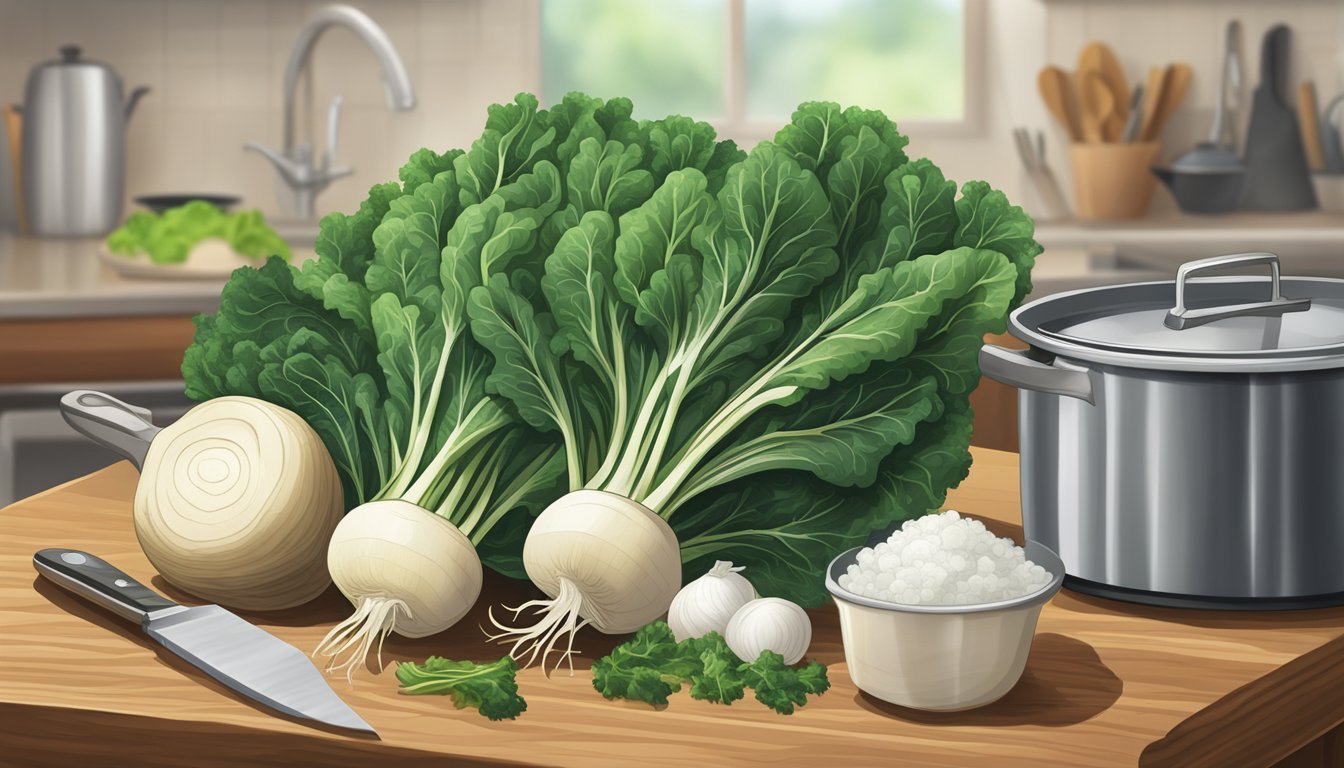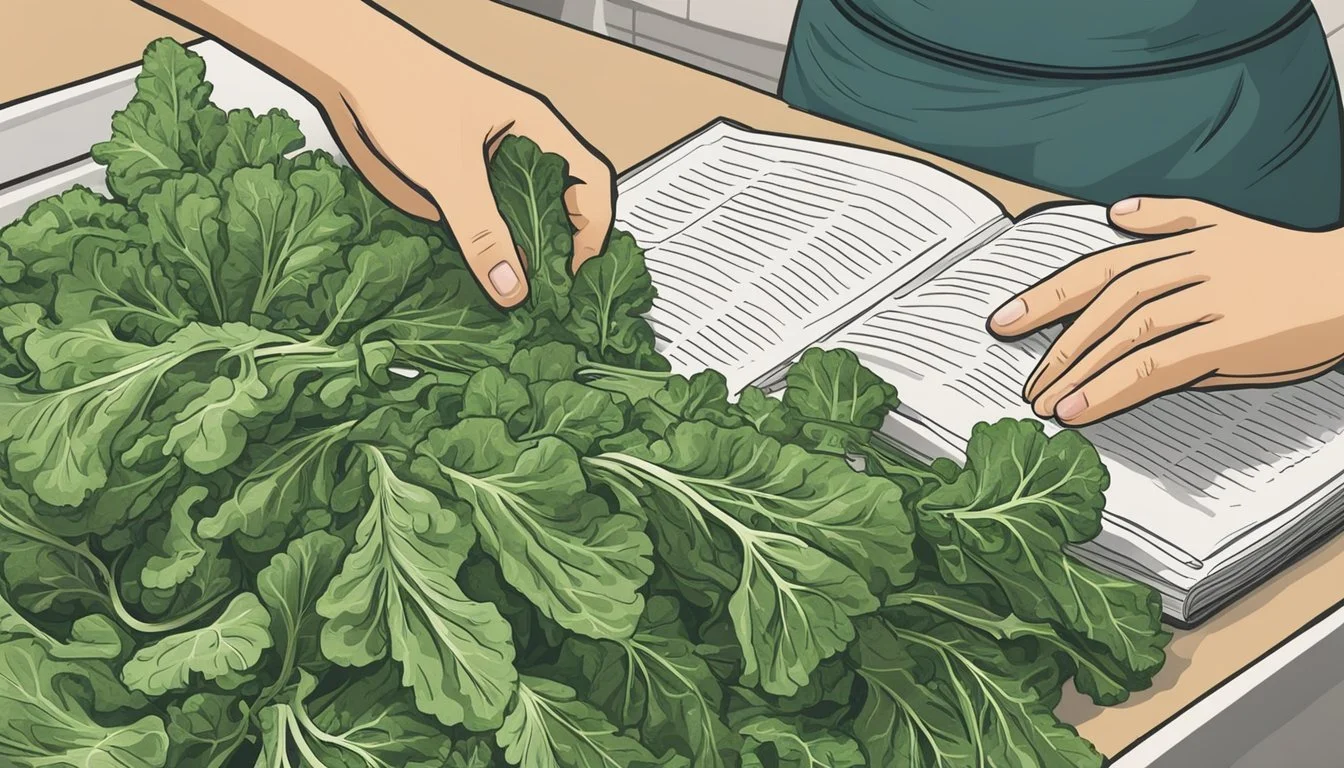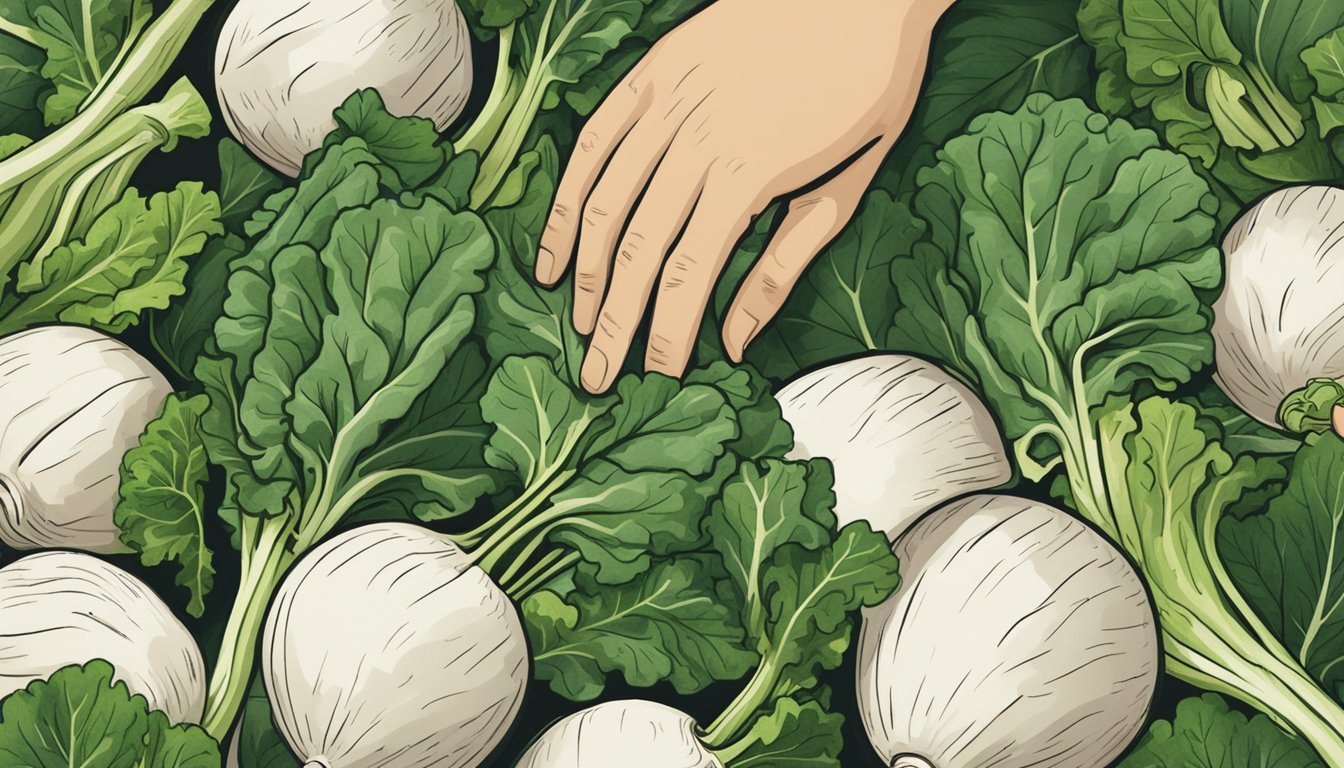How to Substitute Turnip Greens for Collard Greens
A Simple Swap Guide
In the world of leafy greens, collard greens are a staple in many kitchens, known for their hearty texture and slightly bitter taste, which becomes milder when cooked. They are a nutritious addition to diets, packed with vitamins, minerals, and fiber, contributing to a variety of health benefits. However, there are instances when collard greens may not be available, or a different flavor profile is desired in a dish. In such cases, turnip greens offer a suitable alternative, bringing their own set of nutritional benefits and culinary possibilities.
Turnip greens, the top leafy part of the turnip plant, present a more tender option and are often considered sweeter with a robust flavor, distinguishing them from their collard counterparts. They can be cooked similarly to collard greens and are versatile enough to fit into an array of recipes, from stews and soups to sautéed side dishes. The ease of cooking turnip greens makes them an attractive substitute for those looking to try something new in their culinary routine.
When substituting turnip greens for collard greens in recipes, it's important to adjust cooking times accordingly due to the more delicate nature of turnip greens. They require less time to become tender, which can be a considerable advantage for quick meal preparation. Whether incorporated into a traditional recipe or experimented with in new dishes, turnip greens can seamlessly take the place of collard greens, enriching the diet with their nutritional value and enhancing the palate with their distinct taste.
Identifying Turnip and Collard Greens
When substituting turnip greens for collard greens, recognizing their distinctive characteristics is crucial to ensure a compatible match in recipes. This section dissects the visual, flavor, and nutritional aspects that set these leafy greens apart.
Appearance
Turnip greens and collard greens belong to the Brassica family, which also includes vegetables like cabbage and kale.
Broad, flat leaves
Medium to dark green color
Coarse, thicker texture
Turnip Greens:
Smaller, more tender leaves
Medium green color
Slender with lobed or cut leaves
Taste Profiles
These greens bring unique flavors to dishes and knowing their taste profiles is important for substitution.
Collard Greens:
Milder taste, can become slightly bitter
Flavor intensifies when cooked
Turnip Greens:
Sweeter side of the greens spectrum
Peppery and robust flavor similar to mustard greens
Nutritional Comparison
Both greens are packed with valuable nutrients, but they have some distinctions.
Collard Greens (per 100g):
33 calories
5.6g carbohydrates
Rich in vitamins and minerals
Turnip Greens (per 100g):
19 calories
2.81g carbohydrates
Offers a similar vitamins and minerals profile
By understanding these characteristics, one can successfully incorporate turnip greens as a substitute for collard greens without compromising the essence of the dish.
Health Benefits of Leafy Greens
Leafy greens are a cornerstone of a nutritious diet due to their dense content of vitamins, minerals, and fiber. These vegetables can contribute significantly to health maintenance and disease prevention.
Vitamins and Minerals
Leafy greens such as turnip greens and collard greens are rich in essential nutrients. Turnip greens, for example, contain calcium and iron, which are vital for bone health and blood function, respectively. They are also an excellent source of vitamin C, necessary for immune function, and vitamin K, crucial for blood clotting and bone metabolism. Moreover, these greens offer potassium for maintaining healthy blood pressure, folate for DNA synthesis and repair, and vitamin A, which is important for vision and immune function. Magnesium and manganese, minerals present in these vegetables, support numerous enzymatic reactions and overall cellular function.
Calcium: Supports bone health
Iron: Essential for blood production
Vitamin C: Key for immune defense
Vitamin K: Crucial for blood clotting
Potassium: Regulates blood pressure
Folate: Aids in cellular repair
Vitamin A: Important for vision and immunity
Magnesium and Manganese: Facilitate enzyme functions
Dietary Fiber and Digestive Health
Leafy greens are a great source of dietary fiber, which is beneficial for digestive health. The fiber content helps maintain bowel regularity and can prevent constipation. Additionally, fiber aids in achieving a feeling of fullness, which can help with weight management. The presence of fiber in the diet also supports the growth of healthy gut bacteria, contributing to overall gut health.
Dietary Fiber: Enhances digestion and satiety
Reducing Risks of Chronic Diseases
Regular consumption of leafy greens is associated with a lower risk of chronic diseases. The antioxidants and nutrients found in greens like turnip and collard greens may play a role in reducing inflammation and oxidative stress. This, in turn, could decrease the risk of certain types of cancer. The health benefits of these greens extend to potentially reducing the risk of heart disease and supporting healthy aging by protecting cellular components such as DNA.
Antioxidants: Combat oxidative stress
Cancer: Potential risk reduction
Heart Disease: Associated with a lower risk
Culinary Uses of Turnip and Collard Greens
Turnip and collard greens have distinct profiles and are versatile in a range of recipes. Recognizing their unique flavors allows for effective use in cooking.
Cooking Methods
Turnip greens tend to be tender with a sweeter flavor profile, ideal for quicker cooking methods:
Steamed or sautéed: Turnip greens can be lightly steamed or sautéed with garlic and lemon to enhance their natural sweetness.
Salads: Due to their tenderness, turnip greens are also excellent raw in salads.
Collard greens are known for their slightly bitter taste and coarser texture, making them well-suited for longer cooking times:
Soups and stews: Collard greens hold up well in slow-cooked dishes like soups and stews.
Wraps: The sturdy leaves are great for collard wraps as they can be blanched to become pliable yet remain strong enough to hold fillings.
Recipe Adaptations and Substitutions
Adapting recipes to substitute turnip greens for collard greens requires considering the cooking time and the dish's intended flavor:
Bitterness vs. sweetness: For dishes where the bitterness of collard greens is essential, balancing turnip greens with a pinch of salt can mimic the profile.
Cooking time adjustment: When using turnip greens in recipes calling for collard greens, reduce cooking times to avoid over-softening the greens.
Common recipes and how to substitute:
Stews and soups: Use turnip greens in the last few minutes of cooking to preserve their texture and flavor.
Sautéed dishes: Swap turnip greens directly for collard greens, but sauté for a shorter duration.
Pesto and stir-fries: Turnip greens can replace collard greens directly, as they add a similar punch to these quick-prep recipes.
Preparing Greens for Cooking
When substituting turnip greens for collard greens, proper preparation is crucial for maximizing flavor and freshness. This involves thorough cleaning, correct storage methods, and the enhancement of the greens' natural flavors before cooking.
Cleaning and Storing
Turnip greens, like all leafy green vegetables, should be cleaned thoroughly to remove any dirt or debris. They can be rinsed under cool running water or soaked in a bowl of water with a gentle swishing motion to dislodge any remaining grit. Once cleaned, the greens should be dried using a salad spinner or blotted gently with paper towels.
To store turnip greens, they should be wrapped loosely in a damp paper towel and placed in a plastic bag with some air holes for circulation. This setup helps to maintain the right level of humidity. They can then be stored in the crisper drawer of the fridge where they will stay fresh for about three to five days.
How to clean:
Rinse under cool running water or soak and swish in a bowl.
Dry with a salad spinner or pat dry with paper towels.
How to store:
Wrap in a damp paper towel.
Place in a plastic bag with air holes.
Store in the fridge's crisper drawer.
Enhancing Flavors
Before cooking, one can manage the naturally bitter flavor of turnip greens by seasoning them effectively. A sprinkle of salt can reduce bitterness and draw out the moisture, enhancing the greens' inherent sweet notes. For additional flavor, one might incorporate garlic or a dash of lemon juice or vinegar, which will complement the greens without overshadowing their taste. Adding black pepper can add a slight heat and further balance the bitterness.
Here are some ways to enhance the flavor profile of your greens:
To reduce bitterness:
Salt: Add a small amount to lessen bitterness.
Lemon juice or vinegar: Spritz or sprinkle lightly to elevate sweetness and add zing.
To add depth:
Garlic: Incorporate minced garlic during cooking for a robust aroma.
Black pepper: A pinch can add a subtle kick.
It's important to season turnip greens judiciously to enrich their flavor rather than overwhelm it. This careful preparation will ensure that the turnip greens can stand in for collard greens in any recipe, providing a tender and delicious result.
Understanding the Role of Turnip Greens in Diets
Turnip greens are a nutritious leafy vegetable that serve as a low-calorie addition to diets around the world, fitting into a variety of culinary traditions from Southern cuisine to African dishes.
Low-Calorie Considerations
Turnip greens provide dieters and health-conscious individuals an excellent choice when striving to reduce calorie intake without sacrificing nutritional value. One cup of turnip greens contains roughly 30 calories yet is densely packed with vitamins and minerals, making them an ideal component of a low-calorie diet.
Inclusion in Diverse Cuisines
With their tender leaves and distinctive flavor, turnip greens have been embraced in a range of cuisines. They are traditionally featured in Southern cuisine, where they are often cooked and served with other savory flavors. In African culinary traditions, turnip greens can be found both raw and cooked, incorporated into diverse dishes that highlight their versatility in terms of preparation and taste.
Shopping for Turnip and Collard Greens
When seeking out leafy greens, shoppers should consider quality and cost-efficiency, as these factors impact both the nutritional value and the culinary experience when substituting turnip greens for collard greens.
Selecting the Best Quality
When at the store or supermarket, selecting the freshest and most vibrant greens ensures peak flavor and nutrition. Collard greens are typically broad, dark green, and have a somewhat coarse texture. Freshness can be gauged by the leaves' firmness and vivid color, with no yellowing or wilting. Turnip greens, the leafy tops of turnips, should be medium green, tender, and may have a more slender appearance with lobed or cut leaves. When held, they should feel crisp and spring back when gently pressed.
Cost-Efficiency
Collard greens and turnip greens can vary in price depending on the store, season, and organic status. Generally, both greens are considered cost-effective, especially considering their high nutritional value. Shoppers may find turnip greens to be slightly less expensive, as they are often sold with the root, providing two vegetables for the price of one. To maximize value, one can compare prices per pound or per bunch and check for local or in-season availability, which can offer savings and fresher produce.
Substitutes for Turnip and Collard Greens
When collard or turnip greens are unavailable or one desires to explore different flavors, several leafy vegetables serve as excellent substitutes. These alternatives not only bring unique tastes and textures to dishes but also offer various nutrients.
Kale: A dark, leafy vegetable akin to collards and a member of the mustard family, kale is highly nutritious and rich in vitamins. It can be used in place of collard greens, offering a slightly bitter taste and a sturdy texture that holds up well when cooked.
Spinach: Known for its delicate texture and milder flavor, spinach is a versatile substitute that cooks faster than collard or turnip greens and fits well in sautéed dishes or raw salads.
Mustard Greens: For those seeking a peppery kick, mustard greens are an ideal choice. They contribute a spicy flavor that is stronger than that of collard greens, adding zest to recipes.
Vegetable Flavor Note Texture Cooking Suggestion Swiss Chard Slightly bitter Tender Saute or steam Cabbage Mild, sweet Crisp, becomes soft when cooked Braise or stir-fry Chinese Broccoli Bitter, earthy Firm Blanch or stir-fry
Swiss Chard: This green has a comparable bitterness to kale and can act as a stand-in for both turnip and collard greens. Its softer leaves may require less cooking time.
Cabbage: While structurally different, cabbage can mimic the heartiness of collards when chopped and cooked. Its sweeter notes provide a contrast to the more bitter greens.
Chinese Broccoli: Also known as Gai Lan, Chinese broccoli offers a more robust taste and is nutritionally rich. It has a similar bite to kale and works well as a cooked substitute.
By opting for these substitutes, one ensures that meals remain nutritious and flavorsome, offering a variety of textures and tastes to enliven the culinary experience.
Conclusion
Substituting turnip greens for collard greens can fit seamlessly into various cuisines and recipes. Both greens are excellent choices for a nutritious diet, providing a wealth of health benefits.
Turnip greens, slightly sweeter with a tender texture, are a versatile ingredient in the kitchen. They can serve as a stand-in for collard greens in most cooking applications, adjusting cooking times as needed since turnip greens may cook faster due to their tenderness.
Nutritionally, both turnip greens and collard greens are rich in vitamins A, C, and K, contributing to overall health and wellness. Incorporating these leafy greens into meals boosts nutrient intake, supporting everything from skin health to immune function and bone strength.
For those attentive to their health and diet, turnip greens make an excellent alternative to collard greens without significant compromise. They can be sautéed, steamed, or added to soups and stews, enhancing dishes with their robust flavor and nutritional profile.
In summary, when collard greens are not available, or for a variation in flavor and texture, turnip greens are a fitting substitute, providing similar benefits and culinary flexibility.








